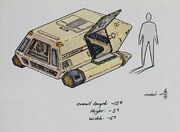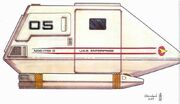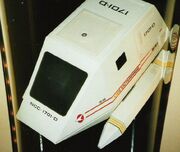m (Bot: Automated text replacement (-ImageCap +imagecap) !!wikia-credits fix!!) |
m (Bot: Automated text replacement (-|Image +| image) !!wikia-credits fix!!) |
||
| Line 1: | Line 1: | ||
{{Sidebar starship class| |
{{Sidebar starship class| |
||
|Name= Type 15 shuttlepod |
|Name= Type 15 shuttlepod |
||
| − | | |
+ | | image= shuttlepod_type-15.jpg |
|imagecap= ''[[Onizuka]]'', a type-15 [[shuttlepod]] |
|imagecap= ''[[Onizuka]]'', a type-15 [[shuttlepod]] |
||
|Affiliation= [[Federation]] [[Starfleet]] |
|Affiliation= [[Federation]] [[Starfleet]] |
||
| Line 8: | Line 8: | ||
|Length= 3.6 meters |
|Length= 3.6 meters |
||
|Crew= 1 or 2 pilots and 1 passenger (in some configurations) |
|Crew= 1 or 2 pilots and 1 passenger (in some configurations) |
||
| − | | |
+ | | image2= Onizuka interior.jpg |
|imagecap2= Craft's interior, single pilot configuration |
|imagecap2= Craft's interior, single pilot configuration |
||
}} |
}} |
||
Revision as of 19:48, 11 March 2011
The type 15 shuttlepod was a Federation shuttlepod carried by Starfleet vessels, a small version of Starfleet's larger shuttlecraft.
Service history
Type 15 shuttlepods were introduced sometime prior to 2365. They were part of the standard shuttle complement on Template:ShipClass, Template:ShipClass, and Template:ShipClass starships. (TNG: "Time Squared", "Identity Crisis"; DS9: "Second Sight")
Technical data
Type 15 shuttlepods were equipped with two long range 750 millicochrane impulse driver engines, also known as impulse nacelles, which were located on either side of the craft. The shuttlepod was also equipped with eight DeFI 657 hot gas RCS thrusters, also known as microfusion thrusters. In addition to a primary deuterium supply, power was provided by three sarium krellide cells. (TNG: "In Theory", "Descent" display graphic) These shuttles did not have warp capability. (TNG: "Time Squared") Type 15 shuttlepods were also equipped with deflector shields. (TNG: "The Mind's Eye")
The open rear hatch of a type 15 shuttlepod
The normal flight crew was two pilots, although the shuttle could easily be operated by a single person. Some configurations even included only a single pilot seat. (TNG: "The Mind's Eye") The ship also had a small cargo space, which could be used for carrying supplies. The cargo area was loaded and accessed through a hatch in the back of the craft. (TNG: "The Most Toys") The type 15 was not normally outfitted to carry passengers, but in some configurations a bench was located in the cargo area for an additional passenger. In this configuration, the cargo hatch included a round emergency egress point, which could be blown away by explosive charges. (TNG: "Power Play")
List of type 15 shuttlepods
- USS Enterprise-D
- #01 - Unknown (TNG: "Devil's Due")
- #03 - Voltaire (TNG: "In Theory")
- #05 - El-Baz (TNG: "Time Squared", "Transfigurations", "Descent", "Descent, Part II")
- #07 - Onizuka (TNG: "The Ensigns of Command", "The Mind's Eye", "The Outcast")
- #09 - Ley (TNG: "The Price")
- #12 - Pike (TNG: "The Most Toys")
- Campbell (TNG: "Power Play")
- Unknown (TNG: "True Q")
Background

Type 15 shuttlepod preliminary sketch
The type 15 designation was never given on screen, but was derived from the Star Trek: The Next Generation Technical Manual. The Manual also stated that the production base of shuttlepods was the Starbase 134 integration facility on Rigel VI. There were in fact three different types of shuttlepods of this design. The type 15 had a delta-v of 12,800 meters per second and a mass of 0.86 tonnes. The type 15A had a delta-v of 13,200 meters per second and a mass of 0.97 tonnes. The type 16 had a delta-v of 12,250 meters per second and a mass of 1.25 tonnes. All types of shuttlepods had the standard armament of two type 4 phasers. Only the type 16 was equipped with the 750 millicochrane nacelles. The type 15 pods had 500 millicochrane nacelles.
In a preliminary sketch from January 1989, Sternbach set the dimensions of the type 15 at 12 feet long, 5.6 feet high and 6 feet wide. (Star Trek: The Next Generation - The Continuing Mission, page 79)
Studio model

The final design sketch

The studio model miniature on tour
The shuttlepod was designed by Rick Sternbach but almost did not get made. It was slated for introduction in the second season episode TNG: "Time Squared" to alleviate the costs associated with building exteriors and mock-ups of the larger, more elaborate types of warp-capable passenger shuttles. These ships were also designated to carry fewer people, and had slower speeds. However, the art department had a bad experience in building the full scale mock-up of the first shuttle, the type 7 shuttlecraft, built for TNG: "Unnatural Selection". The complicated curves of that design caused significant troubles in constructing the mock-up with regard to bending the wood enough. Some of the curves had to be built up with putty. All this resulted in a full scale exterior that was not entirely convincing and could only be shot from limited angles, since only one side was constructed. The art department was less than enthusiastic with the prospect of building yet another complicated shuttle design. Sternbach remembered "Everybody was kind of scratching their heads, and thinking that maybe we'd have to write the shuttlepod out. I cautiously went up to the front of the room with this very rough but fairly clear sketch. I said, "What if we made it fairly simple? just planar construction; no compound curves. We can make it look Starfleet; that isn't the issue. If we do something like this we can make the construction simple, but also make it interesting." They all looked at me, looked at the sketch, and said, "Ahh, OK." Then they approved it." (Star Trek: The Magazine Volume 3, Issue 2, page 112)
Sternbach finalized his design in March 1989 and set designer Richard McKenzie drew up construction plans for the full-scale mock-up which was built with relative ease, resulting in a mock-up which could be shot from all angles. The miniature studio model was constructed by Gregory Jein.
By the fifth season of TNG, the shuttlepod was joined by the larger type 6 shuttlecraft, which also had a full-scale mock-up that matched its filming miniature. The interior set of the shuttlepod was also reused in Star Trek: Deep Space Nine for the cockpit of the Federation attack fighters in "The Maquis, Part II" and the type 18 shuttlepod interior in "The Search, Part I" and "Destiny".
The mock-up was demolished after the series wrapped. As of 2009, the studio model miniature, having escaped the 40 Years of Star Trek: The Collection and It's A Wrap! sale and auction auctions, is still in the possession of Paramount Pictures, having been on tour displays such as Star Trek World Tour, Star Trek: The Exhibition, and Star Trek: The Adventure as late as 2008, labeled "09" though otherwise unnamed.
External link
- Template:Exastris
